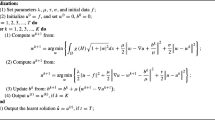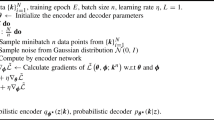Abstract
As an emerging mathematical tool, inverse variational problem approximation (IVPA) has some real applications. Recently, deep learning is used to detect physical phenomena and carry out various tasks, which has achieved promising results. Several works have shown that can learn inverse variational problems (IVPs). In this work, we proposed a new framework to solve mean-curvature-based regularization IVPs from noisy data with different levels based on physical constrained learning and automatic differentiation. Furthermore, traditional variational methods and neural networks-based approaches are integrated, to learn the non-convex and high nonlinear inverse variational problems. And several experiments show that the effectiveness and robustness of our algorithm.





Similar content being viewed by others
References
Kobler, E., Effland, A., Kunisch, K., Pock, T.: Total deep variation for linear inverse problems. In: Proceedings of the IEEE/CVF Conference on Computer Vision and Pattern Recognition, pp. 7549–7558 (2020)
Bredies, K., Kunisch, K., Pock, T.: Total generalized variation. SIAM J. Image Sci. 3(3), 492–526 (2010)
Li, C., et al. Robust PCL Discovery of Data-Driven Mean-Field Game Systems and Control Problems. Circuits and Syst. I: Regular Papers, IEEE Transactions on PP. 99, 1–14 (2021)
Li, F., Zeng, T.: A universal variational framework for sparsity-based image inpainting. IEEE Trans. Image Process. 23, 4242–4254 (2014)
Dobrosotskaya, J.A., Bertozzi, A.: A wavelet-laplace variational technique for image deconvolution and inpainting. IEEE Trans. Image Process. 17, 657–663 (2008)
Tihonov, A.N.: Solution of incorrectly formulated problems and the regularization method. Soviet Math. 4, 1035–1038 (1963)
Bae, E., Shi, J., Tai, X.: Graph cuts for curvature based image denoising. IEEE Trans. Image Process. 20, 1199–1210 (2011)
Chumchob, N.: Vectorial total variation-based regularization for variational image registration. IEEE Trans. Image Process. 22, 4551–4559 (2013)
Gundogdu, E., Constantin, V., Parashar, S., et al. GarNet++: Improving Fast and Accurate Static 3D Cloth Draping by Curvature Loss.[J]. IEEE Trans. pattern. Anal. Mach. Intell. 44(1, 181–195 (2022)
Zhong, Q., Yin, K., Duan, Y.: Image reconstruction by minimizing curvatures on image surface. J. Math. Imaging Vis. 63, 30–55 (2021)
Li, C., Yang, Y., Liang, H., Wu, B.: Transfer learning for establishment of recognition of COVID-19 on CT imaging using small-sized training datasets. Knowl. Based Syst. 218, 106849–106849 (2021)
Sun, J., Li, H., Xu, Z. et al.: Deep ADMM-Net for compressive sensing MRI. In: Advances in Neural Information Processing Systems, pp. 10–18 (2016)
Jin, K.H., McCann, M.T., Froustey, E., Unser, M.: Deep convolutional neural network for inverse problems in imaging. IEEE Trans. Image Process. 26(9), 4509–4522 (2017)
Csáji, B.C., et al.: Approximation with artificial neural networks. Faculty of Sciences, Etvs Lornd University, Hungary 24(48), 7 (2001)
Mumford, D.: Elastica and computer vision. In: Algebraic Geometry and Its Applications, pp. 491–506. Springer (1994)
Fazel, M., Hindi, H., Boyd, S.P.: Log-det Heuristic for matrix rank minimization with applications to Hankel and Euclidean distance matrices. In: Proceedings of the 2003 American Control Conference, 2003., vol. 3, pp. 2156–2162. IEEE (2003)
Chambolle, A., Pock, T.: Total roto-translational variation. Numer. Math. 142(3), 611–666 (2019)
Raissi, M., Perdikaris, P., Karniadakis, G.E.: Physics-informed neural networks: a deep learning framework for solving forward and inverse problems involving nonlinear partial differential equations. J. Comput. Phys. 378, 686–707 (2019)
Sirignano, J.A., Spiliopoulos, K.: DGM: a deep learning algorithm for solving partial differential equations. J. Comput. Phys. 375, 1339–1364 (2018)
Dissanayake, M., Phan-Thien, N.: Neural-network-based approximations for solving partial differential equations. Commun. Numer. Methods Eng. 10(3), 195–201 (1994)
Long, Z., Lu, Y., Ma, X., Dong, B.: PDE-Net: learning PDEs from Data. In: International Conference on Machine Learning, pp. 3208–3216 (2018)
Meng, X., Babaee, H., Karniadakis, G.E.: Multi-fidelity Bayesian neural networks: algorithms and applications. J. Comput. Phys. 438, 110361 (2021)
Cai, S., Wang, Z., Lu, L., Zaki, T.A., Karniadakis, G.E.: DeepM &Mnet: inferring the electroconvection multiphysics fields based on operator approximation by neural networks. J. Comput. Phys. 436, 110296 (2021)
El-Fallah, A.I., Ford, G.: Mean curvature evolution and surface area scaling in image filtering. IEEE Trans. Image Process. 6(5), 750–3 (1997)
Tang, M., Shekhar, R., Huang, D.: Mean curvature mapping for detection of corneal shape abnormality. IEEE Trans. Med. Imaging 24, 424–428 (2005)
Kobler, E., Klatzer, T., Hammernik, K., Pock, T.: Variational networks: connecting variational methods and deep learning. In: German conference on pattern recognition, pp. 281–293, Springer (2017)
Adler, J., Öktem, O.: Learned primal-dual reconstruction. IEEE Trans. Med. Imaging 37(6), 1322–1332 (2018)
Effland, A., Kobler, E., Kunisch, K., et al. Variational Networks: An Optimal Control Approach to Early Stopping Variational Methods for Image Restoration[J]. J. Math. Imaging and Vision. 62(2),(2020)
Aggarwal, H.K., Mani, M.P., Jacob, M.: MoDL: model-based deep learning architecture for inverse problems. IEEE Trans. Med. Imaging 38(2), 394–405 (2018)
Ye, J.C., Han, Y., Cha, E.: Deep convolutional framelets: a general deep learning framework for inverse problems. SIAM J. Imag. Sci. 11(2), 991–1048 (2018)
Sanghvi, Y., Kalepu, Y., Khankhoje, U.K.: Embedding deep learning in inverse scattering problems. IEEE Trans. Comput. Imaging 6, 46–56 (2019)
Goldstein, T., Osher, S.: The split Bregman method for L1-regularized problems. SIAM J. Imaging Sci. 2, 323–343 (2009)
Chambolle, A., Pock, T.: A first-order primal-dual algorithm for convex problems with applications to imaging. J. Math. Imaging Vis. 40, 120–145 (2010)
Wang, Y., Yin, W., Zeng, J.: Global convergence of ADMM in nonconvex nonsmooth optimization. J. Sci. Comput. 78, 29–63 (2019)
Kingma, D.P., Ba, J.: Adam: a method for stochastic optimization. CoRR, vol. arXiv:1412.6980
Zhuang, J., Tang, T., Ding, Y., Tatikonda, S., Dvornek, N., Papademetris, X., Duncan, J.: AdaBelief optimizer: adapting stepsizes by the belief in observed gradients. ArXiv, vol. arXiv:2010.07468 (2020)
Heo, B., Chun, S., Oh, S.J., Han, D., Yun, S., Uh, Y., Ha, J.-W.: Slowing down the weight norm increase in momentum-based optimizers. ArXiv, vol. arXiv:2006.08217 (2020)
Ding, J., Ren, X., Luo, R., Sun, X.: An adaptive and momental bound method for stochastic learning. ArXiv, vol. arXiv:1910.12249 (2019)
Ginsburg, B., Castonguay, P., Hrinchuk, O., Kuchaiev, O., Lavrukhin, V., Leary, R., Li, J., Nguyen, H., Cohen, J.M.: Stochastic gradient methods with layer-wise adaptive moments for training of deep networks. ArXiv, vol. arXiv:1905.11286 (2019)
Lu, L., Meng, X., Mao, Z., Karniadakis, G.: DeepXDE: a deep learning library for solving differential equations. SIAM Rev. 63, 208–228 (2020)
Wang, Z., Bovik, A., Sheikh, H., Simoncelli, E.P.: Image quality assessment: from error visibility to structural similarity. IEEE Trans. Image Process. 13, 600–612 (2004)
Hore, A., Ziou, D.: Image quality metrics: PSNR vs. SSIM. In: 2010 20th International Conference on Pattern Recognition, pp. 2366–2369. IEEE (2010)
Funding
Funding was provided by Natural Science Foundation of China (Grant No. 61731003).
Author information
Authors and Affiliations
Corresponding author
Additional information
Publisher's Note
Springer Nature remains neutral with regard to jurisdictional claims in published maps and institutional affiliations.
Rights and permissions
Springer Nature or its licensor (e.g. a society or other partner) holds exclusive rights to this article under a publishing agreement with the author(s) or other rightsholder(s); author self-archiving of the accepted manuscript version of this article is solely governed by the terms of such publishing agreement and applicable law.
About this article
Cite this article
Liu, H., Hou, C., Qu, H. et al. Learning mean curvature-based regularization to solve the inverse variational problems from noisy data. SIViP 17, 3193–3200 (2023). https://doi.org/10.1007/s11760-023-02544-9
Received:
Revised:
Accepted:
Published:
Issue Date:
DOI: https://doi.org/10.1007/s11760-023-02544-9




